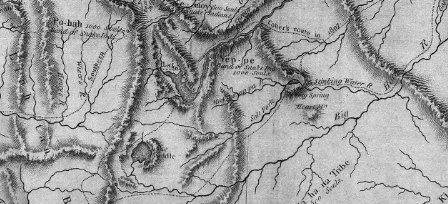In Yellowstone National Park, there’s a river you’ll pass when driving from Madison Junction towards the Norris Geyser Basin. The river, which you’ll see on your right as you drive north, is named the Gibbon River, and there’s a great story of how it received that moniker.
 Back in the early days, YNP wasn’t just a natural attraction; its roads were primary transportation arteries. Right around the turn of the century (not this current one, the one before that), a caravan of stagecoaches was hauling several loads of circus animals through YNP, when an axle broke free from one of the coaches and it overturned. In the ensuing chaos, a number of the monkeys and apes escaped their confinement and the caravan was forced to stop for several days while the escapees were recaptured. While most of the fugitive primates were recovered, a pair of gibbons managed to elude their captors, and the caravan moved on, leaving them to fend for themselves. Amazingly, the two apes managed to survive the harsh Yellowstone climate for several years. Each summer, some lucky stagecoach passengers were treated to a view of the pastoral primates, lounging on the grassy banks of the river. Eventually, the river came to be known as the Gibbon River.
Back in the early days, YNP wasn’t just a natural attraction; its roads were primary transportation arteries. Right around the turn of the century (not this current one, the one before that), a caravan of stagecoaches was hauling several loads of circus animals through YNP, when an axle broke free from one of the coaches and it overturned. In the ensuing chaos, a number of the monkeys and apes escaped their confinement and the caravan was forced to stop for several days while the escapees were recaptured. While most of the fugitive primates were recovered, a pair of gibbons managed to elude their captors, and the caravan moved on, leaving them to fend for themselves. Amazingly, the two apes managed to survive the harsh Yellowstone climate for several years. Each summer, some lucky stagecoach passengers were treated to a view of the pastoral primates, lounging on the grassy banks of the river. Eventually, the river came to be known as the Gibbon River.
I first heard this story from a snowcoach driver in Yellowstone, and it is, as he admitted later, completely fictitious; the river is actually named after Colonel John Gibbon, a member of the Hayden Expedition. The Gibbon River story is one of the more famous examples of tall tales that early Yellowstone stagecoach drivers would inflict on their passengers. The drivers would compete to see which among them could convince their passengers of the most outlandish stories. They called this practice ”stuffing the dudes.” As Burton Harris explains in John Colter: His Years in the Rockies, “Every native-born westerner numbers among his inalienable rights the license to use this technique upon occasion, and considers it a gross breach of hospitality if a visitor leaves without having had a few whoppers thrown in with the usual descriptions of the country and its customs.”

Stuffing the dudes might seem like an odd place to begin a biography of one of the West’s most iconic explorers, but Harris uses it to point out how much of John Colter’s legend is only preserved in oral history. Though he’s recognized as the first white man to explore the Greater Yellowstone Ecosystem, John Colter’s dates of birth and death are both uncertain. He kept no journal. Most of his travels and adventures were recounted by his companions or from stories he told to friends, notably Meriwether Lewis. We may live in the Information Age now, but Colter hails from a disinformation age. Though Harris does his best to separate documented evidence from hearsay, even he can’t resist throwing in a yarn about Colter escaping from an American Indian by spitting a wad of chewing tobacco in his eyes. Still, the well-documented events in Harris’ account of Colter’s adventures are wild enough on their own, no stuffing of dudes required.
There’s the incident on the Lewis & Clark expedition, for example, when expedition member Peter Cruzatte accidentally shoots Captain Meriwether Lewis in the thigh, mistaking him for an elk. Then there’s an account of attempted murder, when Edward Rose, a trapper, attacks his boss Manuel Lisa and later nearly kills him with a swivel gun as Lisa departs the fort. There are also recorded accounts of some of Colter’s martial exploits. While visiting the Crow Indian tribe as a trade emissary, Colter joined the Crows to repel a raid by the Black Feet, as recounted by Major Thomas Biddle: “Coulter [sic], in self defense, took part with the Crows. He distinguished himself very much in the combat; and the Black Feet were defeated, having plainly observed a white man fighting in the ranks of their enemy.” On a later expedition, Colter and his companion Potts are ambushed, Potts is killed, and Colter is captured and stripped naked by Blackfeet Indians. Colter then has to flee the Blackfeet, who set him free with the intent of hunting him, like a frontier version of Surviving the Game. Colter, still stark naked, turns and kills one of his pursuers, then escapes by hiding in a nearby river.

Despite all this action, however, Harris can’t evade the glaring problem of trying to tell an evidence-based account of Colter’s journey through Yellowstone: there just isn’t much evidence at all. There’s the Idaho discovery of the Colter Stone and a blazed tree found by Coulter Creek, but both markers are questionable at best. The most solid evidence comes from the route of Colter’s foray on an 1814 map by William Clark, but Harris still has to spend pages to try and sort out all of the geographic inconsistencies: “The curious, elongated shape of Lake Eustis, as depicted on the 1814 printed map (which can only be Yellowstone Lake), is entirely consistent with the impression Colter must have gained by viewing the South Arm and the Thumb from the distant heights. However, the same of the lake on the printed map for some accountable reason does not agree with that of the manuscript map.” In absence of actual facts, Harris is left to speculate and editorialize. This dose of Harris’ personal thoughts also offer a reminder that this book was first published in 1952: “The Black Feet, who are the Arabs of this region, were at length repulsed, but retired in perfect order and could hardly be said to have been defeated. The Flat-Heads are a noble race of men, brave, generous, and hospitable. They might be the Spartans of Oregon.”
 It took me months to finally finish this book, mostly because I grew weary of Harris trying to reconcile three maps that don’t really resemble one another: William Clark’s 1808 manuscript, the edited version printed in 1814, and the current map of northwest Wyoming. This isn’t a book suited for twenty minutes of reading before bed. The reader really needs full-size printouts of all three maps for reference and a desk to lay them all out on. I’m not saying that it’s not an enjoyable read, but it might be more enjoyable if approached as a geographic treasure hunt rather than as an entertaining historical story.
It took me months to finally finish this book, mostly because I grew weary of Harris trying to reconcile three maps that don’t really resemble one another: William Clark’s 1808 manuscript, the edited version printed in 1814, and the current map of northwest Wyoming. This isn’t a book suited for twenty minutes of reading before bed. The reader really needs full-size printouts of all three maps for reference and a desk to lay them all out on. I’m not saying that it’s not an enjoyable read, but it might be more enjoyable if approached as a geographic treasure hunt rather than as an entertaining historical story.


